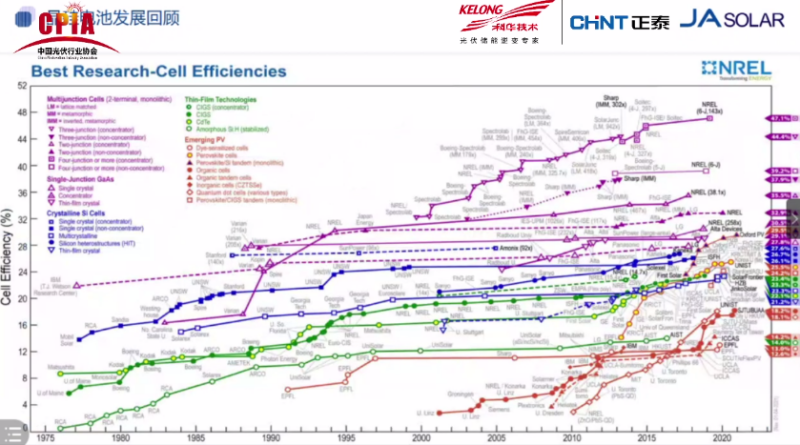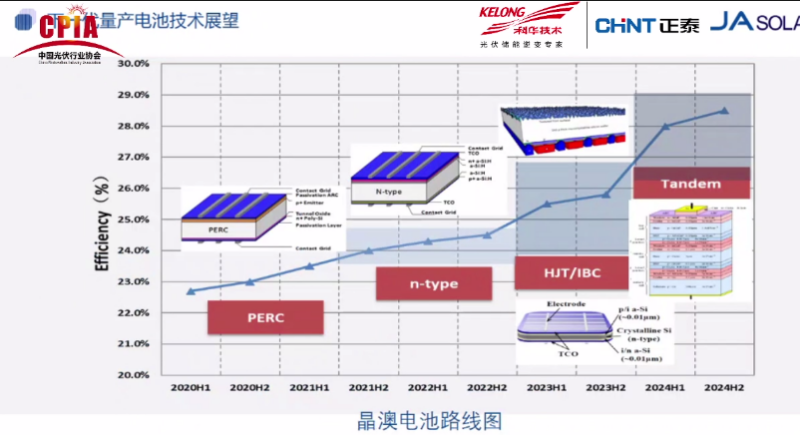PVTIME – During the “2020 Photovoltaic Development Review and 2021 Outlook Conference” held just before the Chinese New Year holiday break, Wang Mengsong, Senior Vice President Assistant and Senior Product Technical Expert of JA Solar, shared a presentation titled “The Development Trend of Crystalline Silicon Cell Technology” covering the following sections.
The silicon solar cell
The world’s first crystalline silicon solar cell was made by Bell Laboratories more than 60 years ago in 1954 and had a conversion efficiency of about 4.5%. In 1958, the first back surface reflector (BSR) solar cell with a conversion efficiency of closer to 10% was introduced to the world. Then, the first full aluminum back surface field (BSF) structure was introduced in 1976 and had a conversion efficiency of 15%. This structure was utilized on a large scale by the industry a few years ago. In 2014, PERC technology was partially mass produced, and gradually became the mainstream cell technology in 2016-17 with its improved structure.
From 2010 to 2020, the conversion efficiency of mass produced crystalline silicon cells has increased rapidly. In 2010, the conversion efficiency of mass produced monocrystalline cells was about 17.5% and 16.2% for polycrystalline cells. Conversion efficiency has subsequently increased by 0.4-0.5% annually. By 2018, the conversion efficiency of monocrystalline cells increased to 20.2%, and by 2019, the conversion efficiency of polycrystalline cells reached 18.7%. By the end of 2020, the conversion efficiency of mass produced PERC cells reached 23%.

Best researched cell efficiencies (Source: NREL)
Current cell structures
With the advancement of technology, several cell structures have emerged in the industry:
PERC, the mainstream technology, has a global production capacity exceeding 200GW, and an annual output exceeding 150GW.
PERT, in which the rear surface is “totally diffused”, is the earliest developed n-type cell. However, it lacks advantages in mass production efficiency and cost.
TOPCon, also known as passivated contact solar cell, is considered an upgrade option by most manufacturers after PERC. By depositing a very thin layer of silicon oxide and a doped polysilicon layer on the back of an n-type silicon wafer, current collection and conversion efficiency are improved. Presently, the conversion efficiency of mass produced TOPCon cells exceeds 24%.
HJT (heterojunction), is another structure that has been heavily discussed by the industry in the past two years. The basic principle of heterojunction is to use amorphous silicon deposition to form a heterojunction on an n-type silicon wafer substrate as a passivation layer. The cell with this structure has a higher open circuit voltage and a correspondingly higher efficiency. Presently, the mass production efficiency of the industry is about 24%.
The interdigitated back contact (IBC) solar cell has back contact energy conversion instead of front contact energy conversion. This allows for the entire front of the cell to absorb sunlight, without any shading from the metal ribbons, generating more energy. The main problem is that the process is relatively complex and the cost is relatively high.
When combined with the heterojunction structure, a so-called heterojunction back-contact (HBC) solar is formed. The HBC cell, in which all the electrodes and p–n junctions are formed on the rear side, exhibits extremely high conversion efficiencies due to the reduction of optical loss as well as the good surface passivation. Under current laboratory conditions, the conversion efficiency for HBC can be as high as 26%.
Moving forward
Based on the current pace of research and development, the conversion efficiency of mass produced PERC cells is expected to increase to 23.5% within two years and 24% in theory. Improvements beyond 24% will become very difficult, especially when facing the challenge of fine-tuning the process for application on larger sized wafers. However, with the efforts of the industry, the conversion efficiency and production yield of 182mm cells can basically reach the same levels as the 166mm cells. In JA Solar’s case, the conversion efficiency of the 182mm cell has exceeded 23%.
For TOPCon technology, production costs should continue to decline and the yield should improve accordingly. The opportunity is that the existing 200GW PERC capacity can be upgraded to produce TOPCon cells at a lower cost compared to other structures. The main challenge would be for it to maintain a lead of more than 1% in efficiency over PERC.
For heterojunction technology, the opportunities lie in its simpler process, higher efficiency, and advantages in slicing and power generation performance due to its low temperature coefficient. The main challenges for HJT are the high materials and equipment cost and maintaining a 1.5% or better efficiency lead over PERC. Furthermore, the cell slicing and module encapsulation processes need to be further optimized to increase the yield.
Of course, in the longer term, achieving 30% conversion efficiency with perovskite tandem cells is a possibility. However, this could take 5-10 years while the bottleneck of cost, stability of industrialization, and the effect of the spectrum on efficiency loss all have to be considered.
 JA Solar cell technology roadmap (Source: JA Solar)
JA Solar cell technology roadmap (Source: JA Solar)
According to JA Solar’s cell technology roadmap, by the end of 2021, the conversion efficiency of PERC cells will be close to 23.5%. By the end of 2022, the conversion efficiency of n-type cells is expected to reach 25%. By the end of 2023, the conversion efficiency of HJT cells is expected to exceed 26%. The goal is that, by 2021, cell technology advancement will push laboratory conversion efficiency to 29%.











